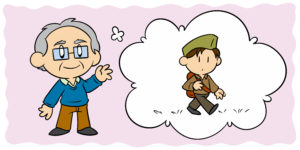The eBook, and the culture of digital publication it spawned, forever changed the publication options open to authors. Those options will only diversify as technology and culture develop to take full advantage of digital content, and with them come a whole host of new opportunities and challenges.
That’s why in this article I’ll be exploring three things that you need to keep in mind when writing a book that’s intended for digital publication. They’re things that physical-copy writers have never had to consider, and while that does mean the digital author has a few more things to worry about, it also means they’re privy to a whole new set of creative opportunities.
We’ll start off with one of the most basic differences between digital and physical books…
1. The reader can only see one page at a time
This is a pretty obvious difference between ways of reading, and yet it’s one which has a definite impact on how a reader experiences a book. We’ve all felt the desperation of reading a gripping story which we can see only has a few pages left to resolve itself, or of talking ourselves into reading on a few more pages because we can see that a chapter is nearly finished.
These things aren’t impossible with an eBook – you can still look ahead a few pages, or look where you are in the page count – but they do require the reader to make a more concerted effort to obtain that information. Knowing ‘where you are’ in a book is information that’s automatically available with a physical copy, and many writers rely on the reader possessing it.
eBooks offer the reader a different experience to physical books – don’t treat them as identical.Click To TweetChristopher Moore’s Lamb is a relatively lengthy book that recounts the New Testament from the point of view of a fictional ‘excised’ character. Since the book engages with such a well-known story, there are expectations on the reader’s part about what will be included.
In fact, the bulk of the story involves the protagonist visiting and learning from the three Magi. The space dedicated to this element of the story might surprise readers, but the book’s physical presentation helps to prepare them for it. Having seen how long is spent with the first Magi, and how much remains of the book, the reader intuits that the second and third visits will be taking up the majority of the narrative.
Likewise, the ending is purposefully abrupt, in relation to both the existing biblical narrative and the story of Lamb itself. Again, this is something which might confuse or irritate the reader if it were not for their ability to see in physical terms that there is not much of the book left in which to wrap up the story. Any sense that ‘the end’ is approaching is rendered as physical reality long before it’s acknowledged in the story.
In the physical copy, the reader is partially prepared for the unexpected subject matter of the story and its abrupt ending, two features of the book which might annoy unprepared readers. The reader may never consciously acknowledge that they’ve picked up this information (and it may be that Moore never intended them to do so), but this doesn’t diminish its influence on how they encounter the book.
The digital author does not have this advantage. The reader can only make these judgements if they make a conscious effort to ‘measure’ the book, an act which means something about the story is already bothering them, even if only slightly.
Some eReaders make the effort to dispel this problem by including a running page count or percentage that is always visible onscreen. Even here, however, utilizing this information takes more conscious effort than with a physical book. It is also very different in how it allows digital writers to control their readers’ perception of the book, something which I will return to shortly.
For now, the question remains as to how the reader’s lack of length perception can be combated. My main tip is to consider using standardized chapter lengths. This allows the reader to define ‘length’ is terms of both the chapter they’re on and the book as a whole. Seeing the number of chapters in the contents, and knowing how long those chapters will be, will give the readers a sense of where they are in the book at any given time. Once again, they’ll instinctively know it’ll only take ‘a few more pages’ to finish the chapter.
The real answer, though, isn’t to recreate the physical book but to reflect on the unique opportunities this offers for digital content. The reader being less sure of where they are doesn’t have to be a bad thing, especially not for horror or crime writers who can utilize this lack of surety to enhance their story.
How can giving your readers less information help you tell a story? Well it all depends on the fact that…
2. Formatting is part of the art form
There are a lot of physical books which utilize formatting as an art form – Mark Z. Danielewski’s House of Leaves being one of the most famous examples – but the difference with digital content is that formatting has to be something you consider when writing your book.
[bctt tweet=”Formatting is a vital tool when writing for digital publication. #indiepub #selfpublishing” username=”standoutbooks”]When considering digital publication, the first question you have to answer is whether you want a ‘standard’ or ‘fixed’ layout. The first allows the reader to adjust the size and style of your font, giving you little control of how the page is structured. On the other hand, a ‘fixed’ layout keeps the page as you’ve designed it at the cost of the reader’s ability to adjust for comfort.
Most authors will choose the former – unless they’re including important images, working in columns, or have other aesthetic concerns – but that’s only the first decision. You’ll also have to decide where sections begin and end, and how the use of blank space will influence your story. Images should also receive a lot of attention – if formatted incorrectly, they can be blown out of proportion, or take up their own pages when they should appear alongside text.
When preparing for digital publication, authors should keep a constant eye on how their final product is formatted. This is where the appreciation of point one comes into play; try to structure the book so that the reader isn’t disadvantaged by its digital nature.
Once you’re past these concerns, however, you’ll find that digital publication actually offers an advantage in terms of formatting freedom. Writers working with physical copies have to deal with the implications of their formatting: House of Leaves may be an exciting read, but by embracing strange formatting such as blank and nearly blank pages, Danielewski has produced a huge tome that’s likely to be one of the biggest on your bookshelf, and certainly isn’t for reading on the train.
Digital publication simply doesn’t create this kind of constraint, and the savvy digital author will find ways to take advantage of that fact. As much potential as this freedom has, it pales in comparison to the opportunities presented by the fact that…
3. There are new toys to play with
There are many different models of eReader, and there’ll be many more in the future, but most come with features beyond simply displaying digital files. These tools – magnification, linked pages, and the ability to add notations to the page – are a treasure trove for digital authors, and one that’s barely been explored thus far.
In House of Leaves there is an appendix containing various documents mentioned in the story. One of these, a letter to a character from his schizophrenic mother, contains a hidden message when certain words are ignored. With a physical copy, this necessitates sitting down with a pen and paper, but in a hypothetical digital version the reader could just highlight the relevant words to similar effect.
Chuck Palahniuk’s Invisible Monsters Remix asks readers to make choices in the narrative and then flick to different pages depending on their decision. Again, in a hypothetical digital version this could be done by ‘linking’ a word or phrase to a page of the book, allowing readers to zip around at the push of a button.
The creative opportunities are myriad, especially when you appreciate points one and two: the reader does not instinctively understand where they are in a book, and your ability to structure it to your liking is far greater than with a physical copy.
The tools available to a digital reader are a treasure trove for ambitious authors.Click To TweetWhy should page twenty follow page nineteen when a linked word can take you anywhere? Fantasy books can have hidden secrets, horrors can whisk you off to a space you don’t understand, appendices no longer need to be clunky additions at the end of a book – you can link to the relevant materials whenever they’re mentioned – and, probably my favourite application of all, mystery novels can allow the reader to interrogate evidence on the page and tag suspicious activity for later referral. Every reader is suddenly equipped with a pen and paper at all times, and that fact alone could change the way we approach crime fiction forever.
Just the beginning
The techniques mentioned above are just some of the things an ambitious, creative author can do with digital publication. As eReader technology becomes more and more ubiquitous, so it will come to include more and more features that authors can hijack for their own ends.
It’s a time and a medium for trailblazers, and it won’t be long before the writers of physical books start to feel jealous of all the things their digital cousins can do.
For more on digital publication and eBook writing, check out How To Price Your eBook and Traditional Vs Self-Publishing – The Fundamentals You Need To Know.
Do you have some unique applications for digital content, or are you just excited to see what your favourite authors will do with it? Let me know in the comments.





